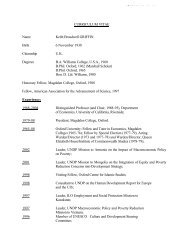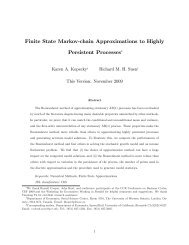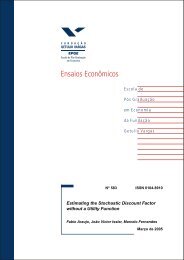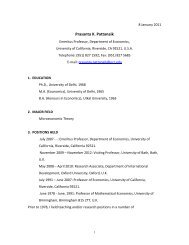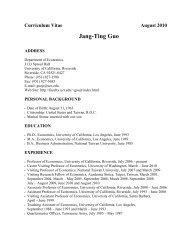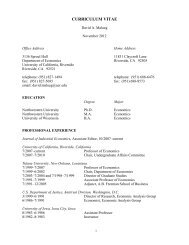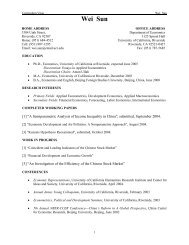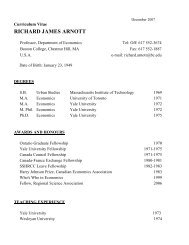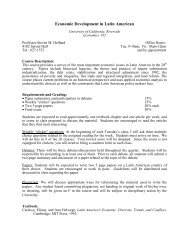Copula-based Multivariate GARCH Model with ... - Economics
Copula-based Multivariate GARCH Model with ... - Economics
Copula-based Multivariate GARCH Model with ... - Economics
Create successful ePaper yourself
Turn your PDF publications into a flip-book with our unique Google optimized e-Paper software.
and Italian Lira). Section 6 concludes. Section 7 is Appendix on copulas.<br />
2 M<strong>GARCH</strong> <strong>Model</strong>s<br />
We begin <strong>with</strong> a brief review of three M<strong>GARCH</strong> models. Suppose a vector of the m return series<br />
{r t } n t=1 <strong>with</strong> E(r t|F t−1 ) ≡ µ t =0and E(r t r 0 t|F t−1 ) ≡ H t where F t−1 is the information set (σ-field)<br />
at time t−1. For simplicity, we assume the conditional mean µ t is zero. For H t ,manyspecifications<br />
have been proposed.<br />
Engle and Kroner (1995) propose the BEKK model<br />
H t = Ω + A(r t−1 r 0 t−1)A 0 + BH t−1 B 0 , (1)<br />
With the scalar or diagonal specifications on A and B, we obtain the scalar BEKK (SBEKK) or<br />
the diagonal BEKK. We use the SBEKK in Section 5, which is<br />
H t =(1− a − b)¯Ω + a(r t−1 r 0 t−1)+bH t−1 , (2)<br />
where ¯Ω = n −1 P n<br />
t=1 r tr 0 t isthesamplecovariancematrixofr t .<br />
Instead of modeling H t directly, conditional correlation models decompose H t into D t R t D t ,<br />
where D 2 t ≡ diag(H t ). As the conditional covariance matrix for ε t ≡ D −1<br />
t r t is the conditional<br />
correlation matrix for r t , The DCC model of Engle (2002) models Q t , the covariance matrix of ε t ,<br />
via a variance-targeting scalar BEKK model:<br />
Q t =(1− a − b) ¯Q + a(ε t−1 ε 0 t−1)+bQ t−1 , (3)<br />
where ¯Q is the sample covariance matrix of ˆε t . A transformation R t = diagQ −1<br />
t Q t diagQ −1<br />
t makes<br />
the conditional correlation matrix for r t .<br />
The VC model of Tse and Tsui (2002) uses the following specification<br />
R t =(1− a − b) ¯R + a ˜R t−1 + bR t−1 , (4)<br />
where ¯R is the positive definite unconditional correlation matrix <strong>with</strong> ones in diagonal, and ˜R t =<br />
P M<br />
i=1 ε P<br />
1,t−iε 2,t−i /<br />
M<br />
i=1 2,t−i´1/2. ε2 1<br />
³ PM<br />
i=1 ε2 1,t−i<br />
1 In Tse and Tsui (2002), a necessary condition to guarantee ˜R t positive definite is M > k. Another necessary<br />
condition for non-singularity of ˜R t, which should be added, is that M should be bigger than the maximum number<br />
of observations of consecutive zeros of ε i,t , i =1,...,k. In the empirical section, we set M =5, which is transaction<br />
days in one week.<br />
2




